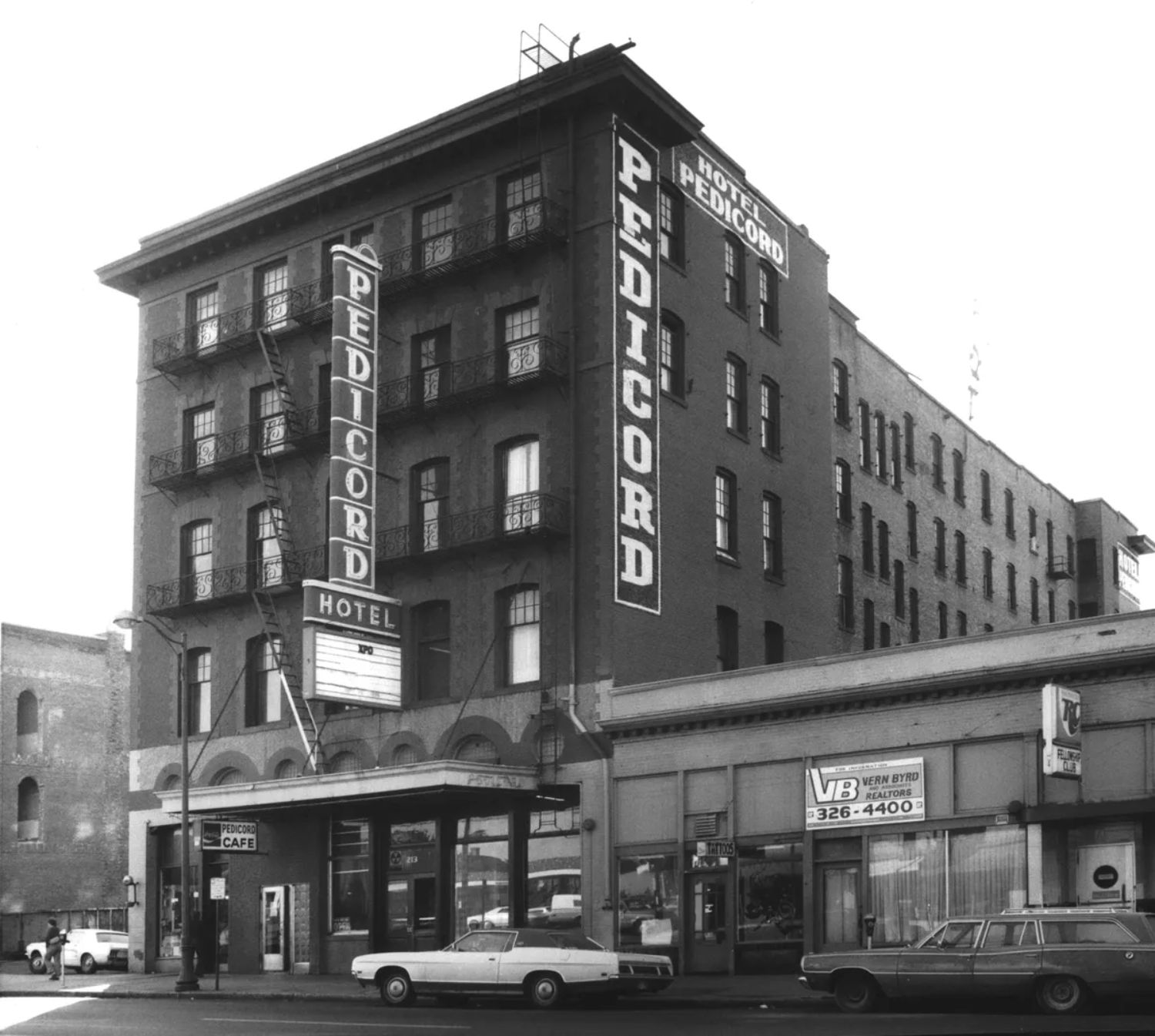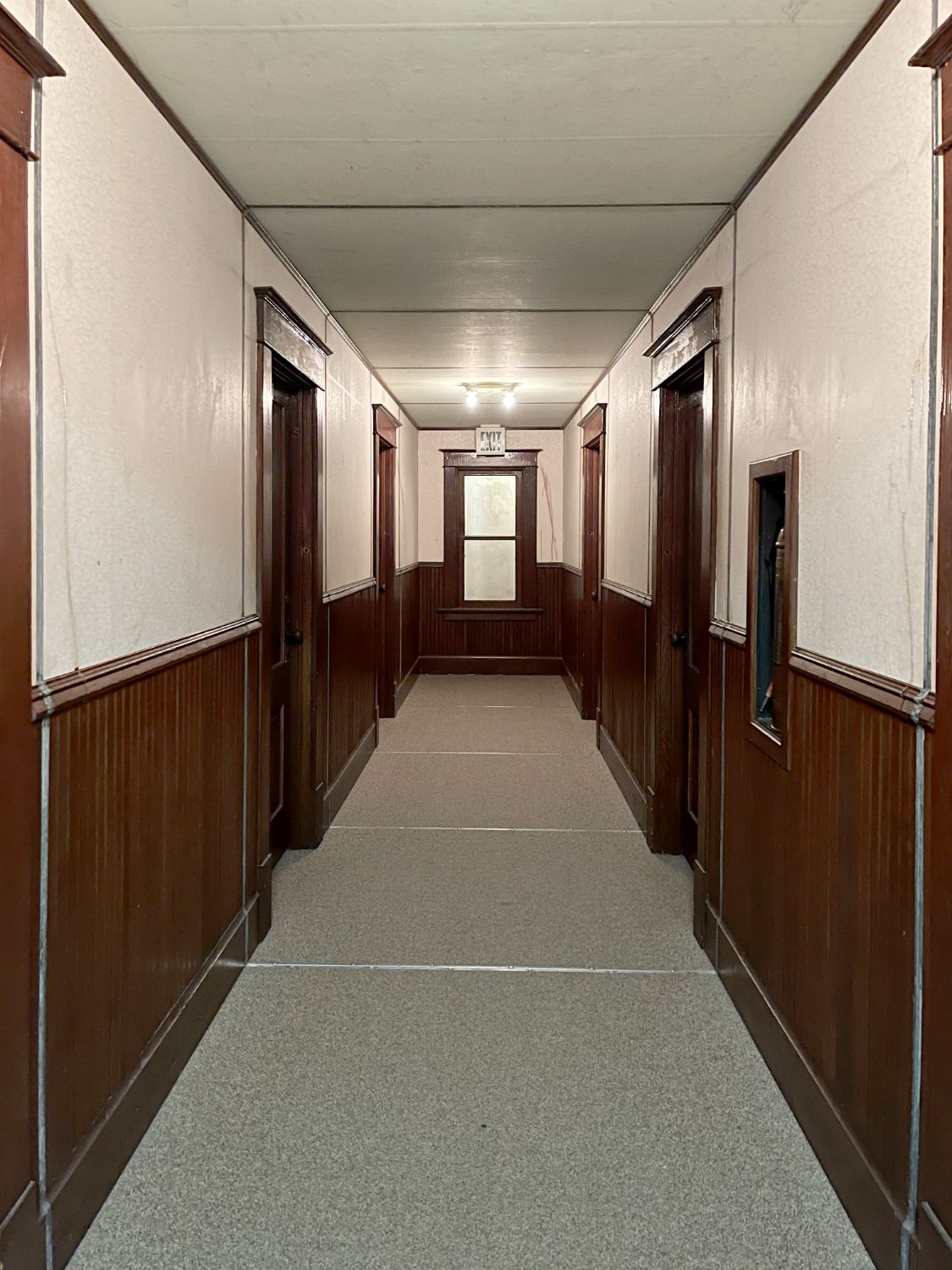
Pedicord Apts: Weisman Mainstay and Twin Cities Sleeper Icon
Published January 27th, 2025 by Sophie Durbin
The 1983 immersive installation by Edward and Nancy Reddin Kienholz invites viewers to imagine the lives and living spaces of strangers
Banner image: Nancy Reddin Kienholz and Edward Kienholz, Pedicord Apts. (detail), 1982-83. Mixed media installation, 120 × 192.75 × 445.5". Image courtesy of Weisman Art Museum.
If I were asked to give my top three most iconic items in Twin Cities art collections, off the top of my head I’d likely say Claes Oldenberg’s Spoonbridge and Cherry in the Walker Sculpture Garden, Rembrandt’s Northern Renaissance masterpiece Lucretia at Mia, and Pedicord Apts. at the Weisman Art Museum. Is one of these things not quite like the others? Sure. But ask anyone who’s visited the Weisman if they remember wandering through an eerie installation that takes the form of a dimly lit hallway, complete with grimy doorknobs you can twist and the faint perfume of stale cigarette smoke — they’re likely to say yes, and as they dust off the cobwebs in their memory, a wistful look might move across their faces.
Pedicord Apts., an installation by Edward Kienholz and Nancy Reddin Kienholz permanently housed at the Weisman, was fashioned out of pieces of Spokane, Washington’s Pedicord Hotel. Pedicord Apts. ensnares its audience through a sense of immersion and play, but the visitor will leave the installation with a peculiar melancholy, a nostalgia for something they can’t quite identify, and likely a hunger to return and explore.
 1979 snapshot courtesy of the Spokane, WA Spokesman-Review of the1893 Pedicord Hotel prior to demolition. The location is now a parking lot.
1979 snapshot courtesy of the Spokane, WA Spokesman-Review of the1893 Pedicord Hotel prior to demolition. The location is now a parking lot.
Visiting in 2024 after popping in sporadically over the years, I was struck by how immediately I was transported upon entry, not just into the semi-fictitious world of the apartment building but into an entirely new persona. The grimy mirrors in the “lobby” area made my own reflection the first thing I saw upon entering and the last thing seen as I left, priming my visit with a grim self-awareness. As I crept through the claustrophobic hallway, turning the knob of each door and eavesdropping on the rooms (motion sensors on each door reward the nosy intruder with sound clips of a woman sobbing, a couple arguing, a television running), I realized that I was being put in the shoes not of one of the building’s residents returning home, but of an outsider.
During my visit, I was reminded of The Power Broker, Robert Caro’s sprawling biography of Robert Moses, who oversaw infrastructure and urban development on an unprecedented scale in twentieth century New York City. In one chapter illustrating Moses’ controversial slum clearance practices, Caro spends some time on what was for me the most memorable detail in the book’s 1200+ pages: in the slums which were ultimately demolished in New York, the hallways were derelict but the rooms themselves were clean1. No matter how squalid the tenement building, people attempted to outfit their spaces with dignity. Wandering through Pedicord Apts., this was never far from my mind. I pictured what might lie beyond each doorknob: a small, perhaps shabby and outdated, but neatly appointed apartment that was someone’s home, a home that was cherished and that was held onto long past the point that the outside world could see its value. By placing the viewer in the role of outsider/intruder, the artists offer Pedicord’s imaginary residents a privacy and ownership over their space that their real-life counterparts were likely not afforded when their building was torn down.
 Interior view of Pedicord Apts. Photo by Sophie Durbin
Interior view of Pedicord Apts. Photo by Sophie Durbin
The installation overflows with little details to discover, and imagined worlds to build. In an article detailing the restoration and conservation of Pedicord Apts. written during the Weisman’s Frank Gehry expansion in 2011, the museum staff provide a list of meticulous multisensory details implemented under the guidance of Nancy Kienholz (Edward died in 1994)2. For example: a new carpet was laid down, only after being appropriately worn out again by children invited by the museum3. The walls and lampshades are stained with drips of something; cigarette butts fill an ashtray; the light fixtures are rusty. Each detail invites a mental journey in which the visitor considers what incidents over time may have led to each little imperfection. Did the apartment building once have a caretaker who would have kept the hallway sparkling clean? When did it fall into disrepair, and when was it decided that it would stay that way — and who got to decide?
As I left the gallery, I overheard another visitor remark to their companion that they “really wanted more” to explore. It was a familiar sentiment for me. What would I give to peek into one of these rooms? Perhaps it’s for the best that I cannot; as I shared above, the artists’ decision to gesture at, but not reveal, the apartment residents’ private lives is a strong creative choice. To me, this is the magic of Pedicord Apts., an artwork with a startling capacity to inspire its audience with its aura of mystery. In this cramped hallway, it is only the visitor’s imagination that limits what may lie behind each locked door. ◼︎
 Interior view of Pedicord Apts. Photo by Sophie Durbin.
Interior view of Pedicord Apts. Photo by Sophie Durbin.
1 Robert Caro, The Power Broker (Vintage Books Edition, 1974), 970.
2 Weisman Art Museum, “Focus on the Collection - Pedicord Apts.” University of Minnesota, 2011.
3 Chris Clayton, “Apartment Hunting: Hiding out at the Weisman, 'The Pedicord Apts.' is ready for your walkthrough.” MSP Magazine, 2016.
Pedicord Apts. is currently on view at Weisman Art Museum. Admission is free and gallery hours are Wednesday 10am – 8pm, Thursday & Friday 10am – 5pm, and Saturday & Sunday 11am – 5pm.
We can't do it without you.
Help keep independent arts journalism alive in the Twin Cities.